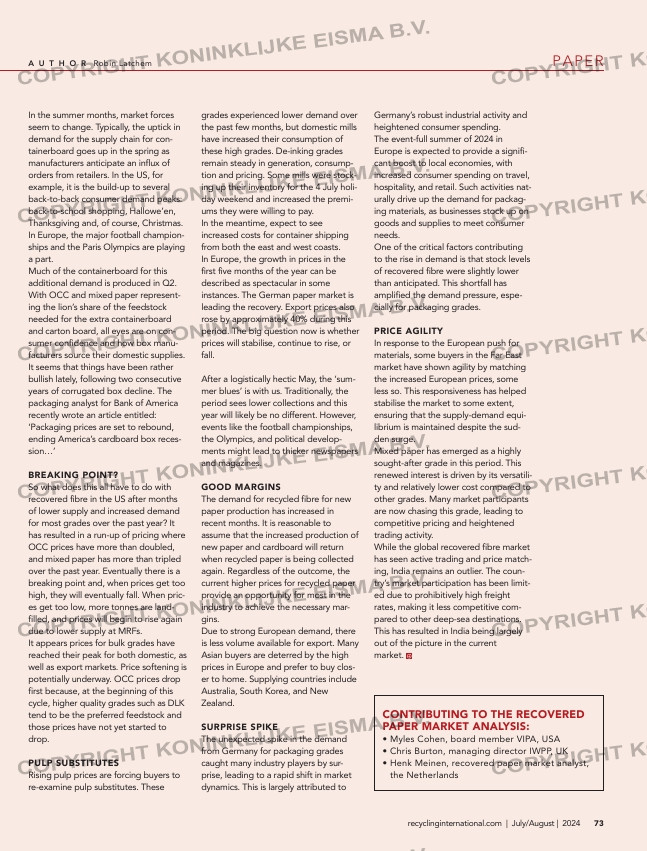Page 73 from: What’s inside issue #4?

PAPER
73recyclinginternational.com | July/August | 2024
CONTRIBUTING TO THE RECOVERED
PAPER MARKET ANALYSIS:
• Myles Cohen, board member VIPA, USA
• Chris Burton, managing director IWPP, UK
• Henk Meinen, recovered paper market analyst,
the Netherlands
Germany’s robust industrial activity and
heightened consumer spending.
The event-full summer of 2024 in
Europe is expected to provide a signifi-
cant boost to local economies, with
increased consumer spending on travel,
hospitality, and retail. Such activities nat-
urally drive up the demand for packag-
ing materials, as businesses stock up on
goods and supplies to meet consumer
needs.
One of the critical factors contributing
to the rise in demand is that stock levels
of recovered fibre were slightly lower
than anticipated. This shortfall has
amplified the demand pressure, espe-
cially for packaging grades.
PRICE AGILITY
In response to the European push for
materials, some buyers in the Far East
market have shown agility by matching
the increased European prices, some
less so. This responsiveness has helped
stabilise the market to some extent,
ensuring that the supply-demand equi-
librium is maintained despite the sud-
den surge.
Mixed paper has emerged as a highly
sought-after grade in this period. This
renewed interest is driven by its versatili-
ty and relatively lower cost compared to
other grades. Many market participants
are now chasing this grade, leading to
competitive pricing and heightened
trading activity.
While the global recovered fibre market
has seen active trading and price match-
ing, India remains an outlier. The coun-
try’s market participation has been limit-
ed due to prohibitively high freight
rates, making it less competitive com-
pared to other deep-sea destinations.
This has resulted in India being largely
out of the picture in the current
market.
grades experienced lower demand over
the past few months, but domestic mills
have increased their consumption of
these high grades. De-inking grades
remain steady in generation, consump-
tion and pricing. Some mills were stock-
ing up their inventory for the 4 July holi-
day weekend and increased the premi-
ums they were willing to pay.
In the meantime, expect to see
increased costs for container shipping
from both the east and west coasts.
In Europe, the growth in prices in the
first five months of the year can be
described as spectacular in some
instances. The German paper market is
leading the recovery. Export prices also
rose by approximately 40% during this
period. The big question now is whether
prices will stabilise, continue to rise, or
fall.
After a logistically hectic May, the ‘sum-
mer blues’ is with us. Traditionally, the
period sees lower collections and this
year will likely be no different. However,
events like the football championships,
the Olympics, and political develop-
ments might lead to thicker newspapers
and magazines.
GOOD MARGINS
The demand for recycled fibre for new
paper production has increased in
recent months. It is reasonable to
assume that the increased production of
new paper and cardboard will return
when recycled paper is being collected
again. Regardless of the outcome, the
current higher prices for recycled paper
provide an opportunity for most in the
industry to achieve the necessary mar-
gins.
Due to strong European demand, there
is less volume available for export. Many
Asian buyers are deterred by the high
prices in Europe and prefer to buy clos-
er to home. Supplying countries include
Australia, South Korea, and New
Zealand.
SURPRISE SPIKE
The unexpected spike in the demand
from Germany for packaging grades
caught many industry players by sur-
prise, leading to a rapid shift in market
dynamics. This is largely attributed to
A U T H O R Robin Latchem
In the summer months, market forces
seem to change. Typically, the uptick in
demand for the supply chain for con-
tainerboard goes up in the spring as
manufacturers anticipate an influx of
orders from retailers. In the US, for
example, it is the build-up to several
back-to-back consumer demand peaks:
back-to-school shopping, Hallowe’en,
Thanksgiving and, of course, Christmas.
In Europe, the major football champion-
ships and the Paris Olympics are playing
a part.
Much of the containerboard for this
additional demand is produced in Q2.
With OCC and mixed paper represent-
ing the lion’s share of the feedstock
needed for the extra containerboard
and carton board, all eyes are on con-
sumer confidence and how box manu-
facturers source their domestic supplies.
It seems that things have been rather
bullish lately, following two consecutive
years of corrugated box decline. The
packaging analyst for Bank of America
recently wrote an article entitled:
‘Packaging prices are set to rebound,
ending America’s cardboard box reces-
sion…’
BREAKING POINT?
So what does this all have to do with
recovered fibre in the US after months
of lower supply and increased demand
for most grades over the past year? It
has resulted in a run-up of pricing where
OCC prices have more than doubled,
and mixed paper has more than tripled
over the past year. Eventually there is a
breaking point and, when prices get too
high, they will eventually fall. When pric-
es get too low, more tonnes are land-
filled, and prices will begin to rise again
due to lower supply at MRFs.
It appears prices for bulk grades have
reached their peak for both domestic, as
well as export markets. Price softening is
potentially underway. OCC prices drop
first because, at the beginning of this
cycle, higher quality grades such as DLK
tend to be the preferred feedstock and
those prices have not yet started to
drop.
PULP SUBSTITUTES
Rising pulp prices are forcing buyers to
re-examine pulp substitutes. These
72-73_mapaper.indd 73 03-07-2024 10:29



